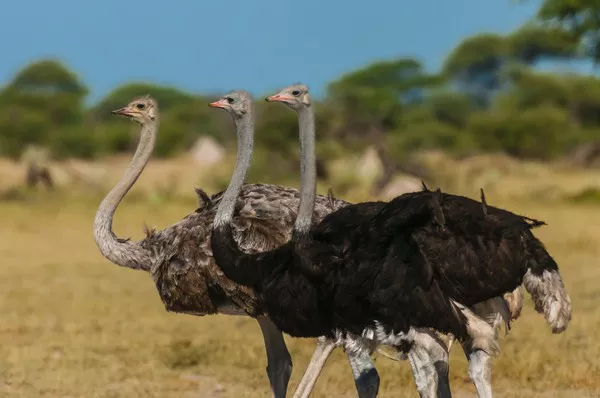Birds come in all shapes and sizes, from the delicate hummingbird to the majestic eagle. Among these avian marvels, some species stand out for their sheer size and grandeur. In this article, we embark on a fascinating journey to explore the largest birds our planet has to offer. From the iconic ostrich to the formidable condor, we delve into the fascinating world of avian giants, unveiling their unique characteristics, habitats, and conservation status.
Top 10+ Biggest Birds in The World (2024)
1. Ostrich (Struthio camelus):
Standing tall as the tallest and heaviest bird on Earth, the ostrich reigns supreme in the avian kingdom. Found primarily in the savannas and arid regions of Africa, the ostrich possesses remarkable adaptations for survival, including powerful legs for running and the ability to sprint at speeds of up to 70 kilometers per hour. Despite its flightless nature, the ostrich compensates with agility and keen eyesight, making it a formidable inhabitant of its native habitat.
2. Emu (Dromaius novaehollandiae):
Native to Australia, the emu ranks among the largest birds globally, second only to the ostrich in height. Renowned for its distinctive appearance and curious demeanor, the emu roams across the vast expanses of the Australian outback, feeding on a diverse diet of plants and insects. Despite facing habitat loss and predation, the emu maintains a stable population, symbolizing resilience amidst environmental challenges.
3. Southern Cassowary (Casuarius casuarius):
Venturing into the dense rainforests of New Guinea and northern Australia, we encounter the enigmatic southern cassowary, a formidable giant among birds. Known for its striking blue skin and helmet-like casque, the cassowary plays a vital role in seed dispersal and forest regeneration. However, habitat destruction and human encroachment pose significant threats to this charismatic species, highlighting the importance of conservation efforts to safeguard its future.
4. Andean Condor (Vultur gryphus):
In the soaring heights of the Andean mountains, the Andean condor commands the skies with its impressive wingspan, making it one of the largest flying birds in the world. Revered as a symbol of power and freedom, the condor’s presence is deeply ingrained in Andean culture and mythology. Despite conservation efforts, the condor faces threats from habitat loss, poaching, and lead poisoning, underscoring the need for concerted action to protect this magnificent species.
5. Dalmatian Pelican (Pelecanus crispus):
Gracing the wetlands and lakeshores of Europe and Asia, the Dalmatian pelican emerges as one of the largest and heaviest flying birds on the continent. With its distinctive pouch and graceful flight, the pelican embodies elegance and adaptability in aquatic environments. However, wetland degradation and disturbance pose significant challenges to the pelican’s survival, highlighting the importance of conservation initiatives to preserve its habitat and ensure its continued existence.
6. Kori Bustard (Ardeotis kori):
Roaming the vast plains and grasslands of Africa, the kori bustard stands out as one of the heaviest flying birds and the largest species of bustard. Renowned for its elaborate courtship displays and booming calls, the kori bustard plays a vital role in savanna ecosystems. Despite facing threats from habitat loss and hunting, conservation efforts offer hope for the preservation of this charismatic species and its iconic habitat.
7. Great Indian Bustard (Ardeotis nigriceps):
Native to the grasslands of the Indian subcontinent, the great Indian bustard symbolizes the rich biodiversity of the region. With its distinctive plumage and formidable stature, the bustard commands attention and respect. However, habitat fragmentation and poaching have pushed this iconic species to the brink of extinction, necessitating urgent conservation measures to secure its future and protect its vanishing grassland habitat.
8. Wandering Albatross (Diomedea exulans):
Navigating the vast expanse of the Southern Ocean, the wandering albatross stands as the largest seabird in the world, renowned for its impressive wingspan and effortless gliding abilities. With wings stretching up to 3.5 meters, the albatross embodies grace and resilience in the harsh marine environment. However, the albatross faces threats from bycatch, plastic pollution, and climate change, highlighting the urgent need for international cooperation to conserve marine ecosystems and protect this majestic species.
9. Trumpeter Swan (Cygnus buccinator):
In the tranquil lakes and marshes of North America, the trumpeter swan reigns as the largest waterfowl species on the continent. With its resplendent white plumage and melodious calls, the swan captivates observers and conservationists alike. Despite successful recovery efforts, habitat loss and human disturbance continue to pose challenges to the swan’s survival, emphasizing the importance of habitat conservation and restoration initiatives.
10. Sarus Crane (Antigone antigone):
Gracing the wetlands and agricultural landscapes of Asia, the sarus crane stands as the tallest flying bird in the world, revered for its grace and beauty. Symbolizing longevity and fidelity in many cultures, the crane holds a special place in the hearts of people across its range. However, habitat loss, pesticide poisoning, and illegal trade threaten the crane’s existence, necessitating concerted efforts to conserve its wetland habitats and mitigate human-wildlife conflicts.
11. Greater Rhea (Rhea americana):
Native to the grasslands and savannas of South America, the greater rhea ranks among the largest birds on the continent, distinguished by its swift running abilities and sociable nature. Despite facing habitat loss and hunting pressure, the rhea adapts well to human-modified landscapes, offering hope for its conservation. However, sustained conservation efforts are essential to address the underlying threats and ensure the long-term survival of this charismatic species.
12. Eurasian Eagle-Owl (Bubo bubo):
Roaming the woodlands and rocky cliffs of Europe and Asia, the Eurasian eagle-owl commands respect as one of the largest and most powerful owls in the world. With its piercing yellow eyes and formidable talons, the owl embodies stealth and strength in the nocturnal realm. However, habitat degradation and human persecution pose threats to the owl’s survival, highlighting the importance of conservation measures to protect its habitat and mitigate human-wildlife conflicts.
13. Mute Swan (Cygnus olor):
Adorning the tranquil lakes and rivers of Europe, the mute swan stands as a symbol of grace and elegance, revered for its beauty and tranquility. Despite its widespread presence, the swan faces threats from habitat degradation, pollution, and invasive species, necessitating conservation efforts to safeguard its habitat and ensure its continued presence in European waterways.
Conclusion:
The world of birds is filled with awe-inspiring giants that captivate our imagination and remind us of the extraordinary diversity of life on Earth. From the towering ostrich to the majestic condor, each species plays a unique role in its ecosystem, shaping landscapes and cultures across the globe. As we celebrate these magnificent birds, let us also redouble our efforts to conserve their habitats and protect them from the myriad threats they face in an ever-changing world. By working together, we can ensure that future generations will continue to marvel at the beauty and grandeur of the world’s largest birds.
You Might Be Interested In:

























